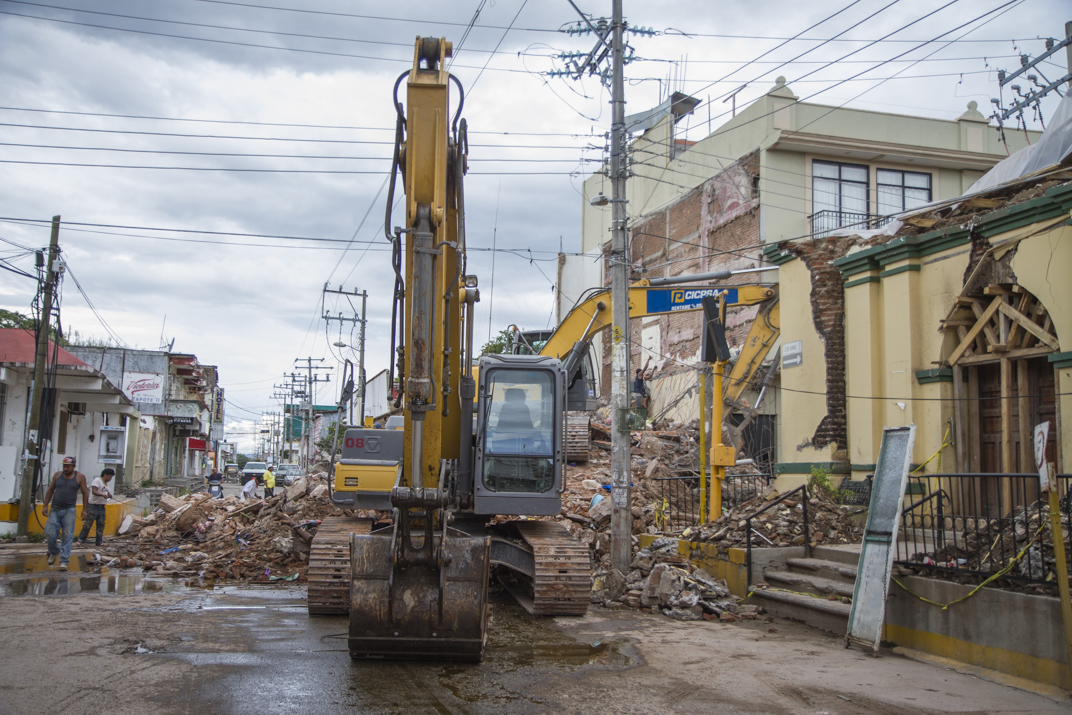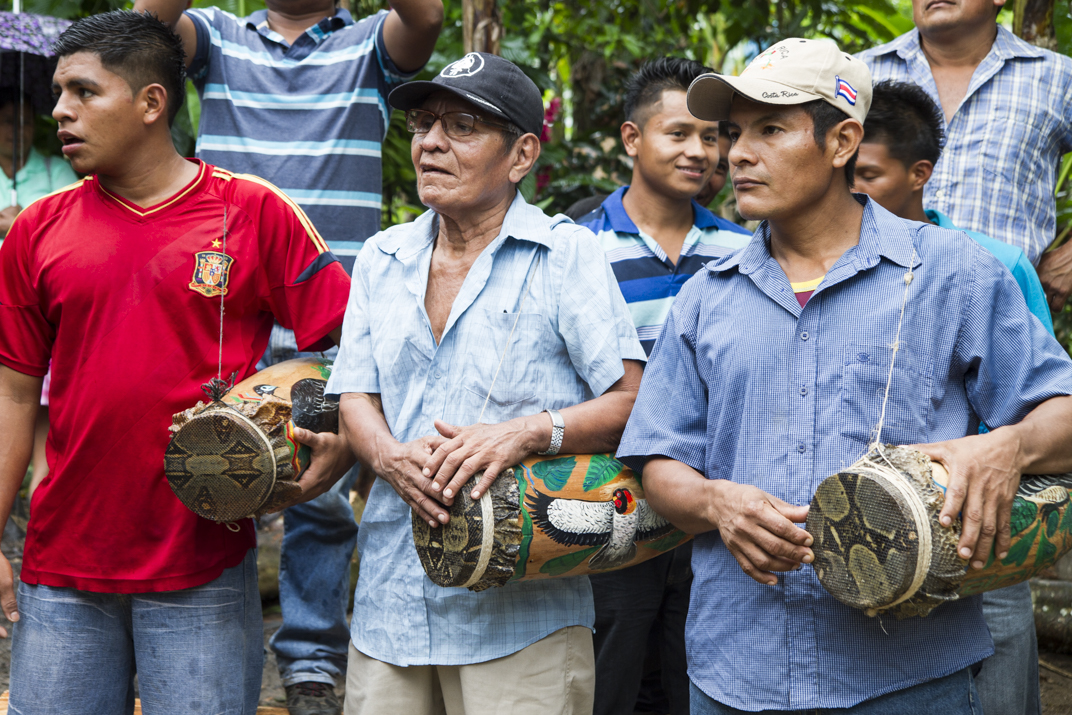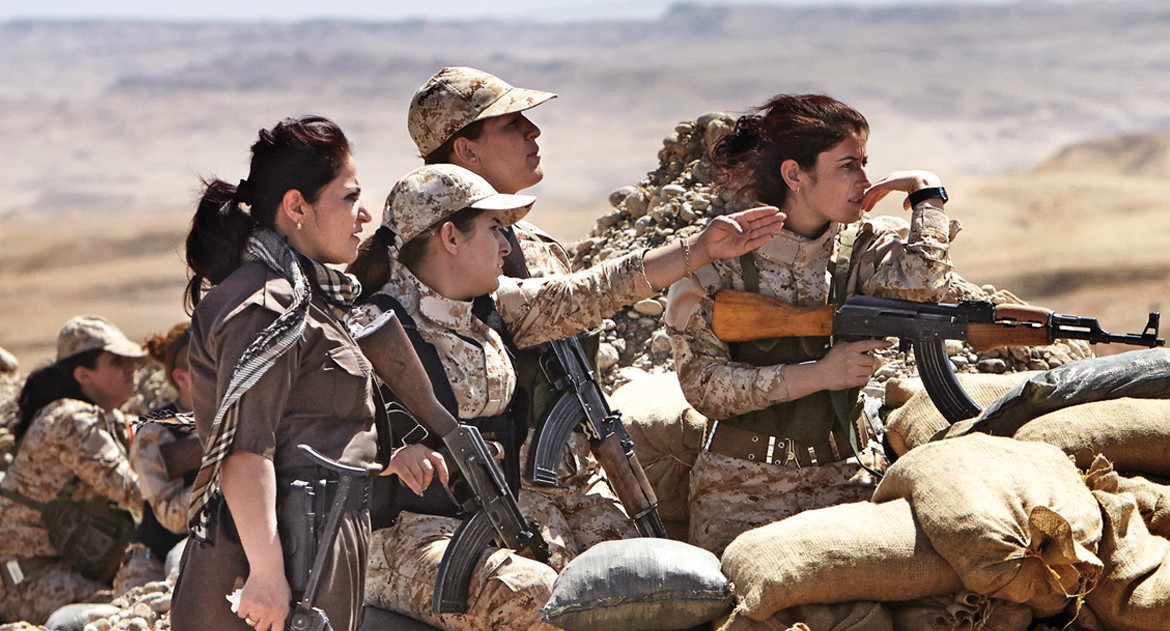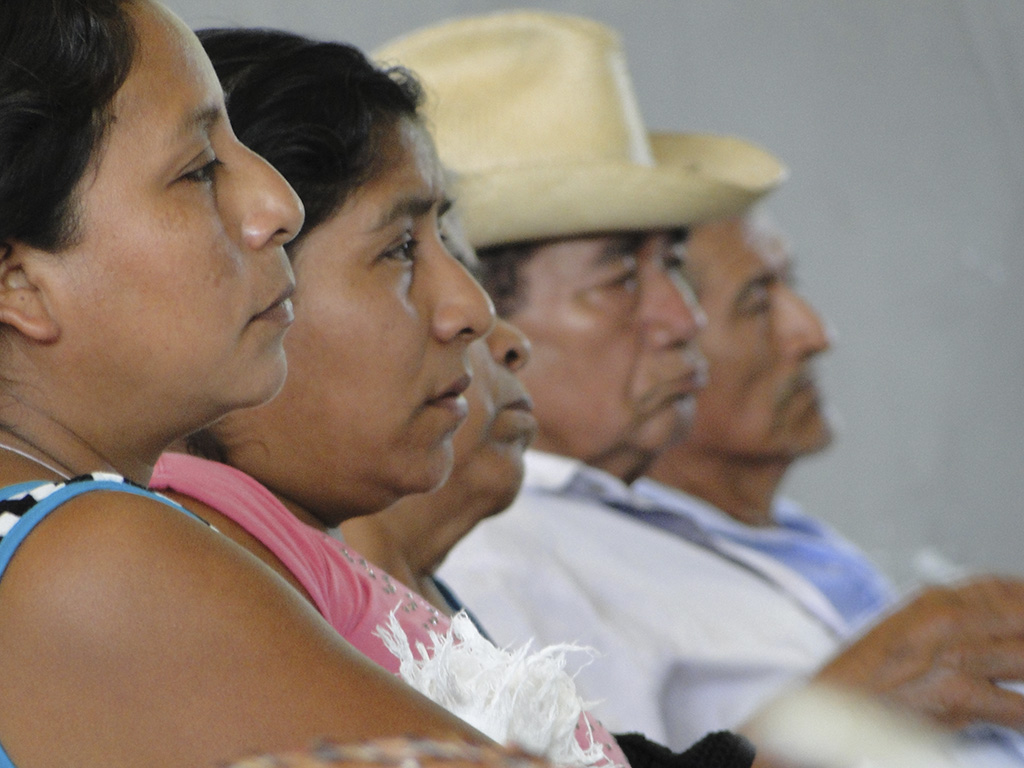The colored tarps hung over streets and patios of homes awaiting repair have become part of the everyday landscape of the Isthmus communities in Tehuantepec, Oaxaca, in southern Mexico, after the 8.2 magnitude earthquake that hit the country on September 7 causing around 100 deaths. It was the most intense earthquake to strike Mexico in a century. People are still afraid and panicked due to the destruction that the earthquake and its aftershocks have caused. The earth still hasn't settled. Since the initial quake, the Mexican National Seismological Service has estimated more than 6,000 aftershocks, in addition to the subsequent earthquake on September 19 that measured a magnitude of 7.2 and devastated Mexico City and other areas of central Mexico. Three hundred and sixty-nine deaths related to the September 19 earthquake have been accounted for as of October 4.
The Isthmus of Tehuantepec, measuring 20,000 square kilometers, is the region that has been most affected by the September 7 earthquake. Official data presented by the government of Oaxaca show that the earthquake affected 120,000 people in 41 different municipalities, and around 60,600 homes. Of those residences, 20,664 were lost completely, while 39,956 sustained partial damage. Their infrastructure, drinking water and sewage systems are damaged. The local economy has taken a hit. The streets are piled with garbage. Many are concerned that a possible health crisis is at hand.
Public officials have resorted to opportunism, making humanitarian relief conditional -- delivering aid upon certain conditions and to supporters of certain political parties.
It's been more than a month since the earthquake and the communal kitchens and tents set up by neighborhoods in public spaces, through their own resources or through donations from people, have become the only option for these communities. Shelters provided for by the state are almost nonexistent. In the municipality of San Mateo del Mar, for example, where 80 percent of homes were affected, the state response was to send the Navy to set up a shelter, but this meager gesture has been surpassed by the organizing of community members, who have found ways to address their most immediate needs.
Seven civilian organizations carried out a humanitarian aid observation mission among the communities in the Isthmus of Tehuantepec region. In their main conclusions, the organizations noted that "the basic, urgent needs of the people affected by the earthquake [have] not been met; and ... a lack of government coordination can be observed in the distribution of humanitarian aid". They also stated that "pre-candidates and public officials have resorted to opportunism by making humanitarian relief conditional, delivering humanitarian aid upon certain conditions to those who are in some way close to the government or to supporters of certain political parties."
The state's immediate policy in reaction to the earthquake was to demolish local homes that had been affected. In the municipality of Ixtaltepec, for example, residents reported that demolitions began hours after the earthquake. "The earthquake happened around midnight and by dawn the machines were already prepared to begin demolition, without any kind of qualified assessment or evaluation", stated a resident of the municipality who prefers to remain anonymous due to safety concerns.
Indeed, the official response to the disaster was top down and ignored the needs and capabilities of local communities, according to residents and organizers.
"This policy of destruction comes from the federal government, without any serious assessment", said engineer Gerardo de Gyves Ramirez, member of the Regional Council for the Reconstruction of Our Towns, made up of organizations and residents of the Isthmus. "Peña Nieto said it: 'I invited my friends who work in construction to come and rebuild.' Who are Peña Nieto's friends? They aren't the local construction workers or engineers. They are individuals that are connected up top. So, what these companies need is for the territory to be cleared so they can act. It means business for the major construction companies. People are scared, they're in shock, and the government is taking advantage of people's fear".
One of the demands of the Council is that there be a serious study of the residences that were affected and that their condition for reconstruction be realistically evaluated.
The Isthmus of Tehuantepec region is rich in culture and traditions, resulting from the diverse ethnic groups that live in the area -- Zapotecs, Chontales, Huaves, Zoques, Mixes, Mixtecs, Tzotziles and Chinantecs. "The home is a fundamental part of the culture of a community. We have a particular architecture that the people of the Isthmus have developed for centuries", Ramirez said.
The government's response to the housing situation has been paltry at best. For example, President Enrique Peña Nieto announced on October 2 that the government would distribute bank cards for monetary compensation. Those whose homes have suffered irreparable damage will receive $6,478; those whose homes sustained partial damage will receive $1,619. Immediately after this announcement, a line of trailers filled with construction materials made an appearance in the municipality of Juchitán, along with a sign that read, "In this establishment the compensatory card is accepted for the purchase of materials".
There is a pervasive feeling among residents of the community that the government does not value their homes or their lives.
Besides the miserly amount offered for the reconstruction of homes, compared to the homes' value, the way in which the compensation is provided presents difficulties for the diverse communities. In the communities along the coast, for example, where houses are built from palm leaves and wood, they will not be able to replace these materials by purchasing them from the construction supply stores that will accept these compensation cards.
Economic and Military Control
"Seven days after the earthquake, they came to my house and condemned it as being irreparably damaged", said Reina Gutiérrez Ruiz, a resident of the San Mateo del Mar municipality. "They simply said, 'Ma'am find somewhere else where you can stay because you can't live here anymore.' And they demolished the house. A government worker arrived and told us that it wasn't an adequate place to build a home and that the government was going to find another place to relocate our house. So, I [asked] him, how are you going to relocate us if our ancestors always lived here?"
This is a common theme among residents of the community: a pervasive feeling that the government does not value their homes or their lives.
"We can't expect blessings from the government; we're a nuisance to them", said Beatriz Gutierrez Luis, teacher of Indigenous education, member of the Coalition of Oaxacan Teachers for Indigenous Recognition and resident of San Mateo del Mar. "For them, it would have been better if the earthquake had completely done away with our villages".
The teacher's statement is supported by the fact that her village has sustained a fierce fight against mega projects that have been present in the region for at least 15 years. "The government has an interest in the community leaving their land", she said. "Our lands are sought after. Even though we rejected the mega project through a town hall meeting, the government wants to install a wind turbine park on our lands. In the Isthmus there are 1,916 wind turbines already installed, and the government plans a second installment phase. We also know there are mining deals but we won't permit that".
Just as in San Mateo del Mar, historically, the entire Isthmus of Tehuantepec is sought after due to its natural resources. "The ransacking of wood, oil, water, minerals and energy has gone uninterrupted", Luis said.
Additionally, the southern border of Mexico is a high traffic corridor between Central and North America, both for goods and for migrants. For this reason, the region is being considered for neoliberal development plans like the Mesoamerican Integration and Development Project. This is an economic integration project which began in 1999 with policy advice and funding from the World Bank and the Inter-American Development Bank (IDB). It includes all seven Central American countries in the construction of wind turbine parks, highways, oil and gas pipelines, and power lines.
More recently, the Mexican government has established Special Economic Zones (SEZ) in the region. SEZs have specific conditions attached that make them highly attractive to potential investors.
The economic control of the region works in conjunction with the Mexican government's plans for population control, such as the Programa Frontera Sur. With the support of the United States, this plan was designed to regulate the travel of migrants en route toward the United States. With the pretense of fighting drug trafficking, it maintains the presence of several different security forces that facilitate large-scale military control of this strategic zone.
Since the earthquake, these communities are being militarized even further. "There is a clear intent to militarize as much as possible to have control over territory, as well as physical and psychological spaces -- all of it being disguised as humanitarian aid. It's brutal", Luis points out.
According to Jehú Pinacho of the Autonomous Investigation Group, the military -- in addition to providing a means of state control over the territory -- is also complicit with the wind turbine companies.
"An example would be the case of Unión Hidalgo, where members of the community informed [us] that Marine Corps members were hoarding the shipments of donated goods sent by civil society to later allow the wind turbine company EDF to label the goods as their own. Afterwards, EDF was accompanied by the Marine Corps to distribute the goods in the streets of the community",
COMMENTED PINACHO.
The Special Economic Zones
Mexico's government has been expressing interest in the construction of a special economic zone precisely in the Isthmus, and the zone in question encompasses the area affected by the earthquake. Two days after the earthquake, the head of the Federal Authority for the Development of Special Economic Zones, Gerardo Candiani accelerated the process of construction of the SEZ in the region, supposedly to reactivate the economic activity of areas affected by the devastation left by the earthquake.
The truth of the matter is that this construction establishes a zone in which enormous privileges are bestowed upon investors, who, in addition to tax exemptions, will have control of movement and security in the region. The design and plan of the SEZ is led by private consultants with the counsel of the IDB. According to the nonprofit Project on Organization, Development, Education and Research (PODER), this new federal government policy represents solidification of the extractivist model and a step toward the privatization of Mexican territory.
The government's response calls to mind Naomi Klein's concept of the "shock doctrine". In The Shock Doctrine, Klein held that while the economic policies of Nobel laureate Milton Friedman and the Chicago School of Economics have had important impacts on countries with free-market models, it is not because they were popular, but rather because the influence of disasters on social psychology creates commotion and confusion which permits the adoption of unpopular reforms.
"It's a very difficult context for us because the government is using the shock doctrine in our region and taking advantage of the devastation", said Carlos Manso, resident of Unión Hidalgo and author of the book Communality, Indigenous Resistance and Neocolonialism. "People are afraid and more worried about meeting their most immediate needs. While in the midst of surviving this catastrophe and forming bonds amongst ourselves, we also have to find a way to mobilize against the government's larger strategy -- to displace us".
Disaster Opportunism
The context of the disaster has been an opportunity for politicians and business people. On September 29, days after Candiani's declaration, the federal government, without first establishing a protocol that would meet the basic needs of the affected communities in Oaxaca and Chiapas, officially announced the declaration of three Special Economic Zones: the Port of Chiapas, Chiapas; Coatzacoalcos, Veracruz; and Lázaro Cárdenas-La Unión, in the states of Michoacán and Guerrero.
Even though the Isthmus of Tehuantepec has not been declared a SEZ during this first stage, Candiani stated that the project has achieved 90 percent of the prerequisites, like territory acquisitions, for it to be declared an SEZ and that this declaration will be made in the coming months.
Oaxaca is a rural and Indigenous state in which communal land comprises 76 percent of the territory, surpassing the total of private property. This is the principal challenge to implementing the SEZs -- the difficulty of privatizing lands, since they are already in the hands of Indigenous people and rural farmers.
In April, 2017, the municipal council of Salina Cruz, a city that will fall within the SEZ, signed an agreement with the Urban Land Tenure Regulation Commission for the State of Oaxaca, with the aim to "regulate" land tenure in areas designated by the government as "irregular human settlements", transforming these lands into private property, state or municipal assets under the argument that it is "the best response to society's demands".
In May, 2017, one month after signing this agreement and several months before the earthquake, Candiani announced that there were 1,230 hectares of land available as concessions to investors.
US and China Will Benefit
The US and China have powerful interests in the Special Economic Zones. In 2009, the US Agency for International Development (USAID) presented a report titled, "Wind Energy Export Potential from Mexico to the US". This document states that Mexico figures as a potential exporter of wind energy to the states of California and Texas. The two most important wind-generating regions in Mexico are the Isthmus of Tehuantepec and Baja California.
China has also shown investment interest in the SEZs, specifically in the areas of administration, construction, development, management and maintenance. China's interests in the steel, metal, agriculture and information technology industries also make the SEZs particularly attractive for investment.
However, amid the accelerating push for development, resistance persists. Indigenous communities are standing their ground against the SEZs. On August 22, just days before the earthquake, representatives of social organizations from 23 municipalities of the Isthmus region gathered for the national forum, "Extractivism or Life" and agreed to reject the SEZs. In their final agreements, they upheld their opposition to extractivism and to SEZs as industrial models that destroy nature and communal property, while directly affecting the local work force, heirloom seeds like corn, and life sources, such as water and energy.







